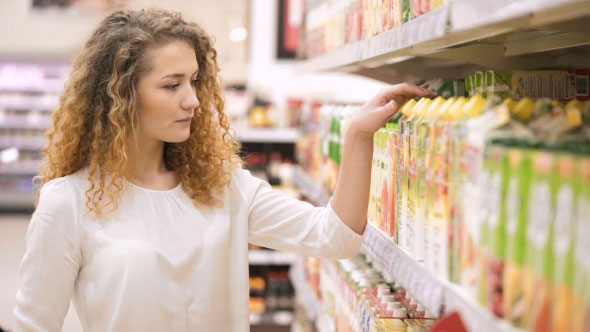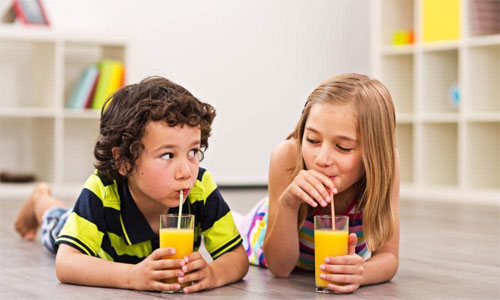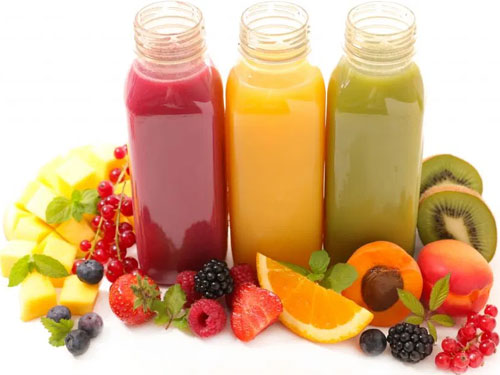Most Fruit Juices Contain No Fruit
Researchers at the University of Connecticut found that many popular fruit juices do not contain fruit, but are instead loaded with water, sugar and artificial sweeteners. The Food and Drug Administration does not require manufacturers to report the precise amount of artificial sweetener used.

Misleading marketing tactics, including pictures of fruit on the package and large advertising budgets aimed at children, have tricked parents into choosing fruit juice, believing they are making a healthy choice.
The precise long-term health impact of artificial sweeteners on children is not known, but the impact on adults is not positive. It is likely a safe assumption that metabolic syndrome, weight gain and nonalcoholic fatty liver disease found in adults consuming artificial sweeteners are the health conditions awaiting children who do the same.
Parents’ good intentions may have been, in part, fueling the childhood obesity epidemic as sugar and sweeteners are highly addictive. Instead of serving fruit juice to children, consider offering fruit smoothies made with real fruit, organic Greek yogurt and coconut water.
The University of Connecticut Rudd Center for Food Policy and Obesity recently released the 2019 Children’s Drink f.a.c.t.s.: Food Advertising to Children and Teens Score, which has triggered several responses. In the report a number of issues were identified relating to advertising, marketing messages and nutritional content of the products.
The enormity of the market in combination with the number of children affected speaks to how important it is to get this information into the hands of parents. According to the report:
“Fruit drinks was the largest children’s drink category, representing more than one-half of all children’s drink sales ($1.2 billion), followed by 100% juice (30% of sales, $0.7 billion). Sales of children’s flavored water and juice/water blends each represented less than 10% of children’s drinks sales, while sales of the one children’s sparkling water brand in our analysis was less than $2 million.
Overall, sweetened drinks represented approximately two-thirds of children’s drink sales ($1.4 billion). Sales of children’s drinks without added sweeteners was $839 million.”
Many parents rely on claims that appear on the packaging. Using an online survey researchers found parents were concerned about sugar and artificial sweetener intake in their children, yet 96% had provided their children an average of 2.9 different types of sugary drinks in the past month. They rated flavored water, fruit drinks and sports drinks as the healthiest types of sugary drinks.
It is likely parents have been deceived by beverage companies that spent $20.7 million in 2018 to advertise their sweetened products to children and parents, as the Rudd Center reports. This is in addition to the $34.4 million spent on advertising drinks without added sweeteners.
Misleading Marketing Tactics of Fruit Juice Packaging
The advertising money is mostly spent on television and magazine ads, relying on visual presentation of product containers, many of which feature fruit. This might make sense if the product contained fruit, but scientists from the Rudd Center found many did not.
Jennifer Harris, Ph.D., director of marketing initiatives at the University of Connecticut and lead author of the study, told Yahoo that while 85% of the drinks featured fruit on the label, only 35% contained any juice at all. She said:
“Most of them didn’t have any juice. I don’t think parents realize that. The packaging of the drinks seem to really be designed to make them seem like they’re healthier than they really are – pictures of fruit on the packages.
The sweetened drinks say things like, ‘Good source of vitamin C’ or ‘100 percent vitamin C.’ They say ‘less sugar than the leading juice’ or ‘less sugar than soda.’ I have parents tell me they’ve been tricked. When they bring them home and look at what’s in it, they can’t believe they bought it.”
The Rudd Center analyzed 34 popular drinks for children ranging from those advertised as 100% juice to those containing low-calorie sweeteners. The researchers found most of the drinks containing juice had no more than 5% fruit juice.
The marketing tactics do not stop at the packaging but move on to advertising. As noted in the report, children from ages 2 to 11 were exposed to twice the number of ads for sweetened drinks than for those without added sugar. They also saw all ads four times more than adults.
Of the ads seen by children, 85% were for two popular, high-selling drinks that do not have juice: Kool-Aid Jammers and Capri Sun Roarin’ Waters. CNN reports some manufacturers have pledged to change their advertising strategies aimed at children, but the American Beverage Association apparently doesn’t believe change is necessary and provided CNN with this statement:
“Our companies strictly follow guidelines established by independent monitors that limit the marketing of beverages to children to 100% juice, water or dairy-based beverages and monitor TV, radio and digital advertising to confirm compliance.”
In response to this, Harris points out children are exposed to advertising while watching television with their parents and … the ABA does not consider packaging designed to appeal to children as marketing to children.”

How Much Artificial Sweetener Is in Fruit Juice?
Even if you’re reading the labels, sweetened fruit drinks can be deceiving since the sugar content may appear lower when manufacturers are using artificial sweeteners. Harris notes the median sugar content in the study was 16 grams in a single serving, brought down by adding low-calorie sweeteners.
Additionally, it’s difficult to know how much is being added, since, according to results from a 2012 study published in Pediatric Clinics of North America, “the FDA does not require manufacturers to report the actual amounts of sweeteners contained in foods and beverages, quantification of the precise amount of sweeteners in food is difficult.”
While there are artificial sweeteners the FDA has approved for use in food, at this point there’s no evidence of their safety or long-term health impact on children. In the sweetened versions, added sugars are a contributing factor to the rapid rise in childhood obesity, which is also “… associated with Type 2 diabetes, nonalcoholic fatty liver disease, hypertension and psychosocial problems,” according to authors of the study.
Artificial sweeteners trigger a cascade of metabolic effects associated with metabolic syndrome, including abdominal obesity, increased insulin resistance, impaired glucose intolerance and high blood pressure. One way artificial sweeteners may increase your risk of diabetes is through the altering of gut microbes.
Research has also convincingly demonstrated that artificial sweeteners stimulate the appetite, increase cravings for carbohydrates and increase the promotion of fat storage and weight gain. Studies have shown that children ages 9 to 14 are negatively affected by artificial sweeteners and that diet soda drinkers suffer the same health problems as those who drink regular soda.
In a study using a 20-year analysis of people from 10 European countries, data pointed to a higher all-cause mortality in those who drank two or more glasses of soft drinks, whether they were sugar-sweetened or artificially-sweetened.
In other words, no matter where you might be consuming artificial sweeteners, they have a significantly negative effect on your health and increase your risk of all-cause mortality.
Is Fruit Juice Soda’s Evil Twin?
Harris warns that avoiding sweetened and artificially sweetened drinks, especially for children under 5, is crucial as it is at this age children develop taste preferences. When they get used to sweet products, it may affect their dietary choices for a lifetime.
In addition to artificial sweeteners, some fruit juices are sweetened with high-fructose corn syrup. This also has a negative effect on leptin and insulin sensitivity, which can lead to metabolic syndrome. High fructose corn syrup is found in myriad processed foods and sweetened beverages.
According to the Hippocrates Health Institute, the average American consumed 40 pounds of sugar a year in 1900; by 2005 they were downing 100 pounds of sugar a year. By 2008 they were also consuming 37.8 pounds of high fructose corn syrup, “mostly unknowingly because it is laced in thousands of processed food and drink products.”
This unchecked dietary habit of sugar consumption has become a major contributing cause of obesity and nearly all chronic degenerative diseases, including nonalcoholic liver disease, with which millions of U.S. children are now struggling.
In addition to problems with sugar, most types of fruit juice introduce yet another health concern. Nearly half of 45 fruit juices tested by Consumer Reports contained elevated levels of heavy metals, including arsenic, cadmium and lead. Toxicity levels are cumulative and may add up from multiple sources over time. Thus, consuming even small amounts may be instrumental in triggering serious diseases, including reproductive problems and Type 2 diabetes.
Good Intentions May Fuel the Childhood Obesity Epidemic
The cumulative effect of these factors means that choices parents make at the supermarket, while initially may be prompted by good intentions, could be fueling the childhood obesity epidemic. Adding insult to injury is the fact that sugar is addictive in any form. It hijacks the reward center in your brain and triggers changes identical to those experienced by drug addicts and alcoholics.
When an individual consumes too much of any hyperstimulating chemical, such as alcohol, sugar or caffeine, the reward center recognizes the overstimulation, which it perceives as adverse to survival.
To compensate, it reduces your sense of pleasure and reward. This survival strategy reduces your experience of pleasure and as a result you develop a tolerance, requiring more of the reward to experience the same pleasure you had before. As cravings grow stronger, your addiction to the substance can increase your risk of addiction to additional substances.
Choose Healthier Drinks for Your Children

Seek out healthier drinks for yourself and your children. Search for products that are filling and full of nutrients and that do not spike your insulin or leptin levels. For instance, filtered water may be flavored at home with a squeeze of lemon or lime. Consider crushing and freezing strawberries or blueberries in ice cube trays to later add to the water.
Coconut water is slightly sweet as well as highly refreshing and hydrating. This may also be frozen in ice trays to be added to filtered water for extra zing. Cold, raw milk is a satisfying and filling drink with a naturally, slightly sweet flavor. However, be aware that coconut water does have fructose in it, so this is something you will want to use in moderation. And, make sure to read labels if you purchase packaged coconut water as it may have added sugars in it.
If it’s fruit flavor your children crave, consider making quick and easy smoothies at home with frozen organic fruit and organic, grass-fed Greek yogurt, without added sweetener. Experiment by adding coconut water to sweeten the smoothie and a frozen banana to add a creamier texture.
yogaesoteric
July 2, 2020
